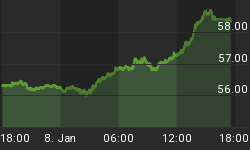Over the past few months you may have heard me refer to the expected bullish conditions that should prevail in 2005 based on stock market history, viz., that there has never been a down X-5 year in the past century. Yet a conflicting view to the expected bull market in 2005 is that with next year being the first year of a new presidential term, history also shows first presidential years to often be bearish. So which historical pattern is likely to prevail in 2005?
To this end, a reader asks, "Even with your explications about the X-5 year of the 10-year cycle, how can 2005 be bullish for stocks when it's a first year's presidency? Are not the first year of the Presidential Cycle bearish, even more so with the 'general conditions' (i.e., debts, rates, Iraq, etc.)? If no one puts a brake in the first year, where will they find the money in the fourth one?"
Let me answer the question about the first year of a new presidential term by referencing cycle expert Larry Williams, who points out that while the first year of a new Presidential term is often bearish, the market has only been bearish 5 of 9 terms as of 1986 (when his book discussing the presidential effect was discussed). If we carry this further to more recent times, we see that the first year of George Bush Sr.'s presidency in 1989 was bullish. The first year of Bill Clinton's first term in 1993 was also bullish. The first year of Clinton's second term in 1997 was also net bullish. Obviously, the first year of Bush Jr.'s term in 2001 was bearish, as was the first year of Ronald Reagan's term in 1981. So that's only two bearish first terms in the past 20 years. Not exactly an unbroken record!
Another consideration when discussing the Presidential Cycle is that the cycle actually begins in the middle of a 4-year presidential term, not at the beginning. This is where most investors seem to err whenever they talk about the Presidential Cycle. While the first year of a 4-year presidential term can sometimes be bearish, it's the end of the second year where the Presidential Cycle bottoms. That leaves the third year of a presidency quite bullish in most cases, followed by an often less-than-stellar fourth and final year.
So where does this leave us in the coming four years? Let's go back to the previous 4-year cycle bottom in late 2002. This coincided with the bear market low of October '02 when the 4-year/12-year cycle bottomed, followed by an overall bullish 2003 (due to the lifting of the downside pressure caused by the "hard down" phase of the previous 12-year cycle).
The 4-year cycle is peaking this year, and this cycle peak will coincide with the bottom of the 10-year cycle this fall. In those years where the first year of a presidential term was net bearish, one thing was usually true, namely, a 10-year cycle was still coming down. With the pressure of the 10-year cycle lifted, what's to keep 2005 from being bullish?
Another reader asks, "What would make you change your mind about the markets? In other words, what index levels need to hold? What about [the recent] PMI divergence (prices up to records, production and orders declining significantly)? What if the economic numbers slow for another month? Does that not change the outlook for earnings? What about stagflation?"

I would answer this question by stating that in order for the bullish outlook to be nullified and the bear to regain control, the S&P 500 would have to break below the mid-900s and the Dow 30 would have to penetrate beneath 8500. As long as these benchmark areas hold, the recovery bull market should continue into the anticipated 2008-2009 peak. The final "hard down" phase of the 10-year cycle from later August through early October will be the best opportunity for the bear to regain control. But the bears will have their work cut out for them and I don't believe they will prevail.
As for the economic numbers slowing for another month, I really don't think this would matter at all. There is already enough divergences among economic statistics (some bullish, some bearish) that we can probably chalk this up to the effects of the 10-year cycle, which tends to make everything seem confusing. This is because the 10-year cycle is part of the larger 20-year cycle, which means that while the 10-year cycle is bottoming, the 20-year cycle is actually peaking. This accounts for the whipsaw, back-and-forth action of the markets and economy typical in a 10-year cycle bottom year.
And so what if certain economic numbers show a bit more erosion in the next couple of months? Fundamentally, a lot of this can be attributed to the Fed's engineered slowdown of the M3 money supply last year, the impact of which is now hitting the economy. But don't forget the Fed in recent months has opened wide the M3 spigot, which means that by next year the economy will reap the benefit of this huge increase in liquidity. This will make up for any temporary downturn in certain economic numbers between now and year-end.

















